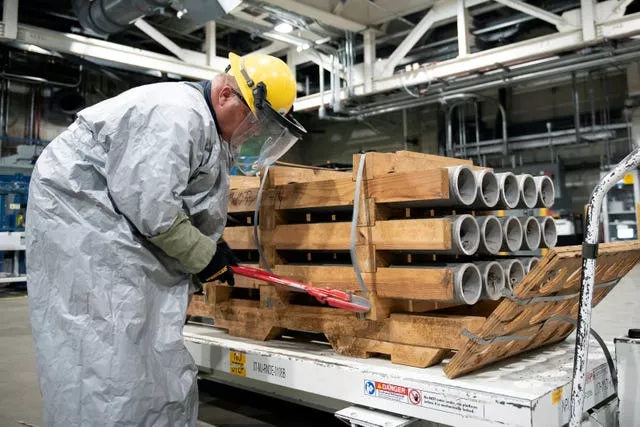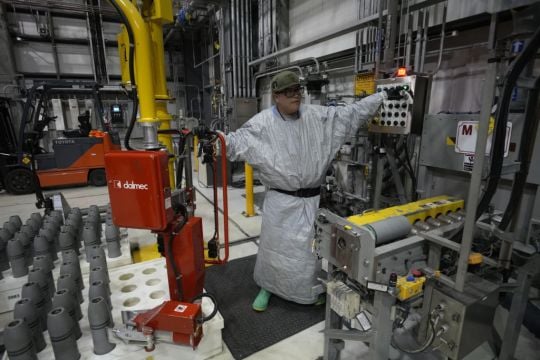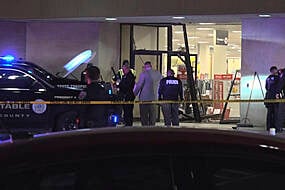The United States has destroyed the last of its declared chemical weapons stockpile, a milestone in the history of warfare dating back to the First World War, Senate Republican leader Mitch McConnell said,
Mr McConnell said in a statement that workers at Kentucky’s Blue Grass Army Depot have eliminated the last of thousands of rockets filled with GB nerve agent that are the last of the United States’ declared chemical weapons and completed a decades-long campaign to eliminate a stockpile that, by the end of the Cold War, totalled more than 30,000 tons (27,216 metric tonnes).
The US faced a deadline of September 30 to eliminate its remaining chemical weapons under the international Chemical Weapons Convention, which took effect in 1997 and was joined by 193 countries.
The munitions destroyed in Kentucky are the last of 51,000 M55 rockets with GB nerve agent — a deadly toxin also known as sarin — that have been stored at the depot since the 1940s.

By destroying the munitions, the US is officially underscoring that these types of weapons are no longer acceptable in the battlefield and sending a message to the handful of countries that have not joined the agreement, military experts say.
Chemical weapons were first used in modern warfare in the First World War, where they were estimated have killed at least 100,000 people.
Despite their use being subsequently banned by the Geneva Convention, countries continued to stockpile the weapons until the treaty called for their destruction.
In June, workers at the Army Pueblo Chemical Depot in Colorado completed their mission of neutralising an entire cache of about 2,600 tons (2,359 tonnes) of mustard blister agent.
Kim Jackson, manager of the Pueblo Chemical Agent-Destruction Pilot Plant, said: “One thing that we’re really proud of is how we’re finishing the mission. We’re finishing it for good for the United States of America.”
The weapons’ disposal alleviates a concern that civic leaders in Colorado and Kentucky admit was always in the back of their minds.

“Those (weapons) sitting out there were not a threat,” Pueblo mayor Nick Gradisar said.
“(But) you always wondered what might happen with them.”
In the 1980s, the community around Kentucky’s Blue Grass Army Depot voiced their opposition to the army’s initial plan to incinerate the chemical weapons.
The community was able to halt the planned incineration plant, and then, with help from politicians, prompted the army to submit alternative methods to destroying the weapons.
Craig Williams, who became the leading voice of the community opposition and later a partner with political leadership and the military, said residents were concerned about potential toxic pollution from burning the deadly chemical agents.
Mr Williams said the military eliminated most of its existing stockpile by burning weapons at other, more remote sites, such as Johnston Atoll in the Pacific Ocean or at a chemical depot in the middle of the Utah desert, but the Kentucky site was adjacent to Richmond and only a few dozen miles away from Lexington, the state’s second-largest city.
“We had a middle school of over 600 kids a mile away from the (planned) smokestack,” Mr Williams said.

The Kentucky storage facility has housed mustard agent and the VX and sarin nerve agents, much of it inside rockets and other projectiles, since the 1940s.
The state’s disposal plant was completed in 2015 and began destroying weapons in 2019.
It uses a process called neutralisation to dilute the deadly agents so they can be safely disposed of.
The project, however, has been a boon for both communities and, facing the eventual loss of thousands of workers, they are pitching the pool of high-skilled labourers as a plus for companies looking to move to their regions.
Workers at the Pueblo site used heavy machinery to meticulously — and slowly — load aging weapons on to conveyor systems that fed into secure rooms where remote-controlled robots did the dirty and dangerous work of eliminating the toxic mustard agent, which was designed to blister the skin and cause inflammation of the eyes, nose, throat and lungs.
Robotic equipment removed the weapons’ fuses and bursters before the mustard agent was neutralised with hot water and mixed with a caustic solution to prevent the reaction from reversing.
The by-product was further broken down in large tanks swimming with microbes and the mortars and projectiles were decontaminated at temperatures of 538C and recycled as scrap metal.

Problematic munitions that were leaky or overpacked were sent to an armoured, stainless steel detonation chamber to be destroyed at about 593C.
The Colorado and Kentucky sites were the last among several sites, including in Utah and the Johnston Atoll, where the nation’s chemical weapons had been stockpiled and destroyed.
Other locations included facilities in Alabama, Arkansas and Oregon.
Kingston Reif, an assistant US secretary of defence for threat reduction and arms control, said the destruction of the last US chemical weapon “will close an important chapter in military history, but one that we’re very much looking forward to closing”.
Officials say the elimination of the US stockpile is a major step forward for the Chemical Weapons Convention.
Only three countries — Egypt, North Korea and South Sudan — have not signed the treaty.

A fourth, Israel, has signed but not ratified it.
Mr Reif noted that there remains concern that some parties to the convention, particularly Russia and Syria, possess undeclared chemical weapons stockpiles.
Biden on Friday urged Russia and Syria to fully comply with the treaty, and called on the remaining countries to join it.
“Today – as we mark this significant milestone – we must also renew our commitment to forging a future free from chemical weapons,” the president said.
Still, arms control advocates hope this final step by the US could nudge the remaining countries to join.
They also hope it could be used as a model for eliminating other types of weapons.
Paul F Walker, vice chairman of the Arms Control Association and co-ordinator of the Chemical Weapons Convention Coalition, said: “It shows that countries can really ban a weapon of mass destruction. If they want to do it, it just takes the political will and it takes a good verification system.”







